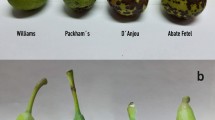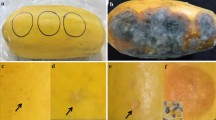Abstract
The inoculum sources of ascospores of Pleospora allii and of conidia of its anamorph Stemphylium vesicarium were investigated in relation to the brown spot disease epidemiology on pear. Dead and living leaves of three pear varieties (Abate Fétel, Conference and William), seven grasses (Poa pratensis, Festuca rubra, Festuca ovina, Lolium perenne, Digitaria sanguinalis and Setaria glauca) and Trifolium repens, which are used in pear orchard lawns, were inoculated with conidia of Stemphylium vesicarium virulent on pear and incubated under controlled-environment. Stemphylium vesicarium was always re-isolated from dead leaves of the considered plants, but not from symptomless green or yellowish living leaves. The fungus was occasionally re-isolated from leaf segments showing unspecific necrosis. Inoculation of pear leaves with isolates from grasses demonstrated that the fungus did not lose pathogenicity. Pseudothecia, ascospores and conidia were produced on all the dead inoculated leaves; differences between specimens were found for phenology of pseudothecia, their density and size, and for the number of conidia produced. Pseudothecia were produced faster in the lawn species than in pear leaves, and their density was higher, especially for S. glauca, L. perenne and P. pratensis. Ascospore maturation and ejection was more concentrated for the pseudothecia developed on pear leaves than for those on F. ovina and S. glauca. All the lawn species produced more conidia than pear leaves.
Similar content being viewed by others
References
TAS Aveling (1993) ArticleTitleStemphylium leaf blight of garlic in South Africa Phytophylactica 25 293–294
CC Berg KT Leath (1996) ArticleTitleResponses of red clover cultivars to Stemphylium leaf spot Crop Science 36 71–73
D Blancard E Allard P Brest (1989) ArticleTitleLa Stemphyliose du poirier ou « macules brunes » Phytoma 406 37–38
Bugiani R, Giosuè S, Rossi V and Spada G (2004). I modelli previsionali per la lotta alla maculatura bruna del pero. www.phytomagazine.com, 3(6): 43–50
P Cavanni I Ponti (1994) ArticleTitleMaculatura bruna del pero: una micopatia sempre d’attualità Rivista di Frutticoltura 56 37–42
C Chaisrisook DL Stuteville DZ Skinner (1995) ArticleTitleFive Stemphylium spp. pathogenic to alfalfa: Occurrence in the United States and time requirements for ascospore production Plant Disease 79 369–372
AM Chowdhury A Asheque M Zaman MA Bakr A Ahmed (1996) ArticleTitleSporulation of Stemphylium botryosum Wallr Journal of Mycopathological Research 34 69–71
H Ataide ParticleDe RK Hegde (1988) ArticleTitleVitamin requirements of Stemphylium lycopersici – a causal agent of leaf spot of tomato Current Research University of Agricultural Sciences Bangalore 17 148–149
JA Duke (1981) Handbook of Legumes of World Economic Importance Plenum Press New York
K Elena (1996) ArticleTitleFirst report of Stemphylium botryosum causing Stemphylium leaf spot of asparagus in Greece Plant Disease 80 342
MB Ellis (1971) Dematiaceous Hyphomycetes Commonwealth Mycological Institute Kew, Surrey, UK
MB Ellis JP Ellis (1985) Microfungi on Land Plants MacMillan New York, USA
S Frayssinet (2002) ArticleTitleStemphylium vesicarium Wallr. nuevo patogeno de alfalfa en Argentina Agro Ciencia 18 3–7
JH Graham FI Frosheiser DL Stuteville DC Erwin (1979) A Compendium of Alfalfa Diseases American Phytopathological Society St. Paul, Minnesota, USA
MK Hausbeck J Hartwell JM Byrne B Benson (1999) ArticleTitleEpidemiology of Stemphylium leaf spot and purple spot in no-till asparagus Acta Horticulturae 479 205–210
S Hetherington B Auld M Priest H Smith N Tuat ParticleVan P Du ParticleVan (1996) ArticleTitlePreliminary surveys and pathogenicity testing of fungi isolated from the annual grass weeds Avena spp. and Lolium rigidum Bioherbicide Paper Plant Protection Research Institute 1 11
SS Jakhar JC Duhan LS Suhag (1996) ArticleTitleStudies on the epidemiology and survival of Stemphylium vesicarium (Wallr.) Simmons in debris and seeds of onion Seed Research 24 135–140
S Larran C Monaco HE Alippi (2000) ArticleTitleEndophytic fungi in beet (Beta vulgaris var. esculenta L.) leaves Advances in Horticultural Science 14 193–196
B Leuprecht (1988) ArticleTitleStemphylium, eine wichtige Krankheit an Spargel Gesume München 24 235–236
I Llorente E Montesinos (2002) ArticleTitleEffect of relative humidity and interrupted wetness periods on brown spot severity of pear caused by Stemphylium vesicarium Phytopathology 92 99–104
I Llorente E Montesinos (2004) ArticleTitleDevelopment and field evaluation of a model to estimate the maturity of pseudothecia of Pleospora allii on pear Plant Disease 88 215–219
Llorente I, Villardel P, Moragrega C, Bonaterra A and Montesinos E (2003). Biology, epidemiology and integrated control of Stemphylium vesicariumon pear, an emerging disease of economic impact in Europe. In: 8th International Congress of Plant Pathology (19.29 pp. 264), Christ Church, New Zealand
ES Luttrell (1981) The pyrenomycete centrum-Loculoascomycetes DR Reynolds (Eds) Ascomycete Systematics Springer Verlag New York 124–137
E Maccaferri M Collina A Brunelli (2003) ArticleTitleStudies on the epidemiology of Stemphylium vesicariumon pear Journal of Plant Pathology 85 310
JM Mackie DL Lloyd MJ Ryley JAG Irwin (1999) ArticleTitleFungal diseases of temperate annual pasture legumes in southern Queensland Australian Journal of Experimental Agriculture 39 699–707
SA Menzies PG Broadhurst CM Triggs (1992) ArticleTitleStemphylium disease of asparagus (Asparagus officinalis L.) in New Zealand New Zealand Journal of Crop and Horticultural Science 20 427–433
E Montesinos P Vilardell (1992) ArticleTitleEvaluation of FAST as a forecasting system for scheduling fungicide sprays for control of Stemphylium vesicarium on pear Plant Disease 76 1221–1226
E Montesinos C Moragrega I Llorente P Vilardell (1995a) ArticleTitleSusceptibility of selected European pear cultivars to infection by Stemphylium vesicarium and influence of leaf and fruit age Plant Disease 79 471–473
E Montesinos C Moragrega I Llorente P Vilardell A Bonaterra I Ponti R Bugiani P Cavanni A Brunelli (1995b) ArticleTitleDevelopment and evaluation of an infection model for Stemphylium vesicarium on pear based on temperature and wetness duration Phytopathology 85 586–592
AHS Onions D Allsopp HOW Eggins (1981) Smith’s Introduction to Industrial Mycology EditionNumber7 Edward Arnold (Publishers) Ltd. London UK
NR Pataky (1992) Summer patch and necrotic ring spot of lawns and fine turfgrasses University of Illinois Extension Urbana-Champaign, USA
Peat H and Fitter A (2001). The ecological flora of the British Isles at the University of York. In: http://www.york.ac.uk/res/ecoflora/cfm/ecofl/
Picco AM, Betto A and Porri A (1996). Stemphyllium, Pleospora and Alternaria airspores in a pear tree orchard: A three year quantitative monitoring in Italy. In: 1st European Symposium on Aerobiology (pp. 156–157), Santiago de Compostela, Spain
M Polfliet (2002) ArticleTitleInfection of Stemphylium increases every year Fruitteelt Den Haag 92 16–17
I Ponti F Laffi (1993) Malattie crittogamiche delle piante da frutto Edizioni L’informatore Agrario Verona, Italy
I Ponti P Cavanni A Brunelli (1982) ArticleTitleMaculatura bruna delle pere: eziologia e difesa Informatore fitopatologico 32 35–40
Prados AM, Melero JM and Basallote MJ (1994). Development of the teleomorph of Stemphylium vesicarium in garlic debris affected by leaf spots. In: Proceedings of the 9th Congress Mediterranean Phytopathological Union (pp. 159–161), Kusadasi-Aydin, Turkey
AM Prados-Ligero JL Gonzalez-Andujar JM Melero-Vara MJ Basallote-Ureba (1998) ArticleTitleDevelopment of Pleospora allii on garlic debris infected by Stemphylium vesicarium European Journal of Plant Pathology 104 861–870
AM Prados-Ligero JM Melero-Vara C Corpas-Hervías MJ Basallote-Ureba (2003) ArticleTitleRelationships between weather variables, airborne spore concentrations and severity of leaf blight of garlic caused by Stemphylium vesicariumin Spain European Journal of Plant Pathology 109 301–310
VV Rajani PP Rawal RR Khandar (1991) ArticleTitleCultural studies on Stemphylium lycopersici causing leaf spot of tomato Indian Journal of Mycology and Plant Pathology 21 38–42
D Realise P Castagne H Coupard L Kaluzny-Pinon C Reynier C Waligora C Zambujo (2002) ArticleTitleEn France: l’année 2002 se fait la poire belle Arboriculture Fruitière 565 25–42
SY Shi KY Kuang (1991) ArticleTitleBiological characteristics of onion leaf blight fungus Journal of Shanghai Agricultural College 9 40–44
EG Simmons (1969) ArticleTitlePerfect states of Stemphylium Mycologia 61 1–26
P Singh R Bugiani P Cavanni H Nakajima M Kodama H Otani K Kohmoto (1999) ArticleTitlePurification and biological characterization of host-specific SV-toxins form Stemphylium vesicarium causing brown spot of European pear Phytopathology 89 947–953 Occurrence Handle1:CAS:528:DyaK1MXmslWns7o%3D
P Singh P Park R Bugiani P Cavanni H Nakajima M Kodama H Otani K Kohmoto (2000) ArticleTitleEffects of host-selective SV-toxin from Stemphylium vesicarium, the cause of brown spot of European pear plants, on ultrastructure of leaf cells Journal of Phytopathology 148 87–93 Occurrence Handle1:CAS:528:DC%2BD3cXivVelt7w%3D
H Suheri TV Price (2000) ArticleTitleInfection of onion leaves by Alternaria porri and Stemphylium vesicarium and disease development in controlled environments Plant Pathology 49 375–382
H Suheri TV Price J Armstrong (2001) ArticleTitlePurple leaf blotch disease of Allium spp. in Australia Acta Horticulturae 555 171–173
MKH Sultanova MM Tashpulatov BN Abdullaev (2002) ArticleTitlePathogenic microflora of plants damaged by cotton whitefly Zashchita i Karantin Rastenii 3 45
Tadayuki S (2003). Illustrated encyclopaedia of forage crop disease. In: http://ss.ngri.affrc.go.jp/disease/detitle.html
P Villardel (1988) ArticleTitleStemphylium vesicarium en plantaciones de peral Fruticoltura professional 18 51–55
JF Dijke ParticleVan (2002) ArticleTitleIncidence of pear fruit spot can increase explosively Fruitteelt Den Haag 92 8–9
MMdeJ Yanez KS Osada (1990) ArticleTitleFactores que estimulan la esporulacion de Stemphylium solani in vitro Revista Mexicana de Fitopatologia 8 52–58
Author information
Authors and Affiliations
Corresponding author
Rights and permissions
About this article
Cite this article
Rossi, V., Pattori, E., Giosué, S. et al. Growth and sporulation of Stemphylium vesicarium, the causal agent of brown spot of pear, on herb plants of orchard lawns. Eur J Plant Pathol 111, 361–370 (2005). https://doi.org/10.1007/s10658-004-5273-3
Accepted:
Issue Date:
DOI: https://doi.org/10.1007/s10658-004-5273-3




